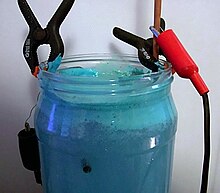Copper(II) hydroxide
 |
|
 |
|
| Names | |
|---|---|
|
IUPAC name
Copper(II) hydroxide
|
|
| Other names
Cupric hydroxide
|
|
| Identifiers | |
|
3D model (JSmol)
|
|
| ChemSpider | |
| ECHA InfoCard | 100.039.817 |
| KEGG | |
|
PubChem CID
|
|
| UNII | |
|
|
|
|
| Properties | |
| Cu(OH)2 | |
| Molar mass | 97.561 g/mol |
| Appearance | Blue or blue-green solid |
| Density | 3.368 g/cm3, solid |
| Melting point | 80 °C (176 °F; 353 K) (decomposes into CuO) |
| negligible | |
|
Solubility product (Ksp)
|
2.20 x 10−20 |
| Solubility | insoluble in ethanol; soluble in NH4OH, KCN |
| +1170.0·10−6 cm3/mol | |
| Thermochemistry | |
|
Std molar
entropy (S |
108 J·mol−1·K−1 |
|
Std enthalpy of
formation (ΔfH |
−450 kJ·mol−1 |
| Hazards | |
| Main hazards | Skin, Eye, & Respiratory Irritant |
| Safety data sheet | http://www.sciencelab.com/xMSDS-Cupric_Hydroxide-9923594 |
| NFPA 704 | |
| Flash point | Non-flammable |
| Lethal dose or concentration (LD, LC): | |
|
LD50 (median dose)
|
1000 mg/kg (oral, rat) |
| US health exposure limits (NIOSH): | |
|
PEL (Permissible)
|
TWA 1 mg/m3 (as Cu) |
|
REL (Recommended)
|
TWA 1 mg/m3 (as Cu) |
|
IDLH (Immediate danger)
|
TWA 100 mg/m3 (as Cu) |
| Related compounds | |
|
Other anions
|
Copper(II) oxide Copper(II) carbonate Copper(II) sulfate Copper(II) chloride |
|
Other cations
|
Nickel(II) hydroxide Zinc hydroxide Iron(II) hydroxide Cobalt hydroxide |
|
Related compounds
|
Copper(I) oxide Copper(I) chloride |
|
Except where otherwise noted, data are given for materials in their standard state (at 25 °C [77 °F], 100 kPa).
|
|
|
|
|
| Infobox references | |
Copper(II) hydroxide is the hydroxide of copper with the chemical formula of Cu(OH)2. It is a pale greenish blue or bluish green solid. Some forms of copper(II) hydroxide are sold as "stabilized" copper hydroxide, although they likely consist of a mixture of copper(II) carbonate and hydroxide. Copper hydroxide is a weak base.
Copper(II) hydroxide has been known since copper smelting began around 5000 BC although the alchemists were probably the first to manufacture it by mixing solutions of lye (sodium or potassium hydroxide) and blue vitriol (copper(II) sulfate). Sources of both compounds were available in antiquity.
It was produced on an industrial scale during the 17th and 18th centuries for use in pigments such as blue verditer and Bremen green. These pigments were used in ceramics and painting.
Copper(II) hydroxide can be produced by adding a sodium hydroxide to a dilute solution of copper(II) sulfate (CuSO4·5H2O). The precipitate produced in this manner, however, often contains water and an appreciable amount of sodium hydroxide impurity. A purer product can be attained if ammonium chloride is added to the solution beforehand. Alternatively, copper hydroxide is readily made by electrolysis of water (containing a little electrolyte such as sodium sulfate, or magnesium sulfate). A copper anode is used, often made from scrap copper.
...
Wikipedia

